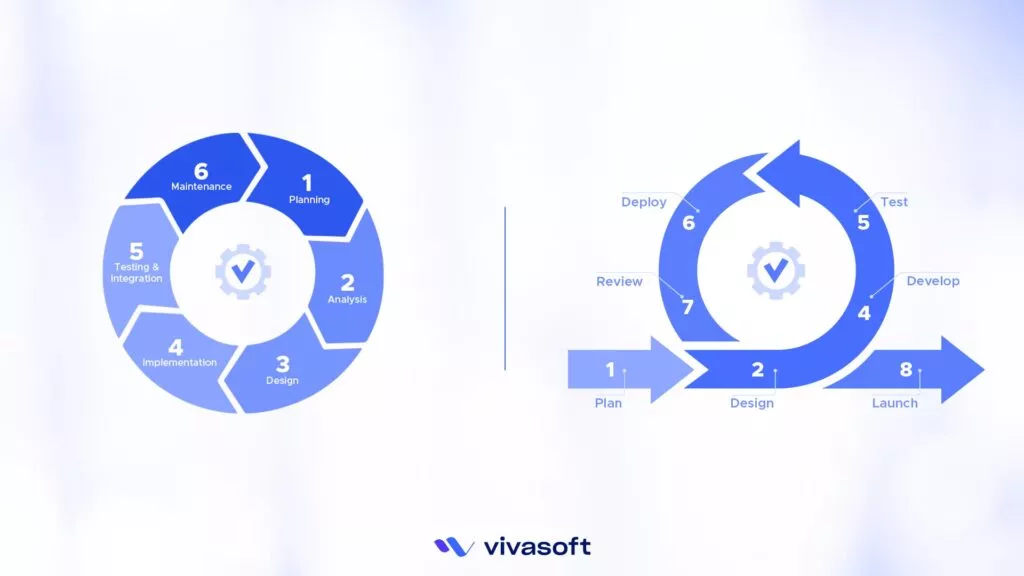What is end to end testing vs integration testing? In-depth software testing and post-analysis serve as surveillance in your highly technical journey of software development. Wondering how? Software testing safeguards against bugs and guarantees flawless functionality of your developed program. Besides, testing is the foundation of a complete quality assurance that results in secure software.
Two essential processes in software testing include integration testing and end-to-end (E2E) testing. While integration testing explores the interactions between specific modules, end-to-end testing evaluates the software system as a whole, simulating actual user scenarios.
As a software developer, you must understand how these approaches differ from one another in depth. Let’s dive into knowing the different approaches and core differences between these testing processes to provide a seamless application to a user.
Overview of End to End Testing

End To End (E2E) software testing process is one of the major foundations of assuring quality and secured software before it goes live for the users.
What Is End-To-End (E2E) Testing?
Once you have developed a prototype of the software, it needs to be tested from the target user’s perspective. End-to-end software testing is a thorough quality assurance procedure that analyzes the functionality of the software system as a whole.
In this method, you need to simulate actual user circumstances to ensure a smooth compilation of every step and code of the program. Moreover, you will not only find the anomalies and potential bugs that hinder the functionality but also ensure to fix the issues.
As a result, the whole software development process goes through all the steps and ensures a reliable and error-free user experience in the end.
Objectives and Goals of End to End Testing
Complete Software testing achieves crucial objectives and goals for maintaining an efficient and faultless software system:
- Verify the functionality of the finished software system from the viewpoint of the user through systemic validation.
- Assure smooth interaction and communication between all integrated components using integration assurance.
- Verify that the workflow’s overall layout meets user requirements.
- Find and fix any bugs that might appear in the software program.
- Ensure a satisfactory and error-free user experience in practical situations.
- Risk mitigation is the process of identifying possible threats to the entire software system to reduce the possibility of data loss or thievery.
Key Features of End to End (E2E) Testing
End-to-end testing is distinguished from other testing methods by some crucial key features that elevate its effectiveness in real-time.
Scopes of Testing
Going through the entire software system, End-to-End Testing helps you to systematically assess every aspect of the application. It includes a testing perspective from the user interface to backend processes.
Moreover, it verifies end-to-end workflows, ensuring that your software performs smoothly across various user journeys and scenarios.
The broad scope facilitates the identification of potential errors and defects when the application is fully activated.
Inclusion of Multiple Components
This approach checks out the interaction and collaboration between multiple software modules and their functionality. Along with that, it includes the testing of integrated components, databases, and external interfaces. The E2E method also focuses on how data flows between different components, addressing potential issues related to data exchange.
Simulation of Real User Scenarios
The most important feature of the E2E testing includes real-world user scenarios. This testing method ensures that the software behaves as expected in practical situations.
It helps you feel and experience the issues from the end user’s perspective resulting in making it better.
Besides, this step helps you identify performance issues and ensures the software can handle various usage patterns and stress conditions.
Advantages of End to End Testing
All-inclusive Bug Detection
This process finds bugs in all integrated components of your developed program. Hence, you are assured of a lower possibility of problems when the product is released.
Real-World Scenario Simulation
Software performance in real-world interactions is mimicked in E2E helping to develop a more user-friendly interface.
Better Software Reality
A greater level of assurance in the software’s resilience is gained by stakeholders through extensive testing. As a result, it reduces risks and builds up trust in your software’s dependability.
Challenges In End To End Testing Process

Although End-to-end software gives a rock-solid performance in software development, it also faces some challenges.
- Evaluating all of the system’s complex features can be laborious and complex. This puts a strain on project deadlines and takes much time to launch software.
- Testing across integrated components is resource-intensive and may influence project costs. You might need a higher budget to comply with the requirement of a significant amount of resources.
- Possibility of False Positives End-to-end testing’s thoroughness may cause false positives, necessitating meticulous analysis to separate real problems from imagined ones.
Overview of Integration Testing
The integration software testing process allows you to test and troubleshoot each of the software modules separately.
What Is Software Integration Testing?
Software testing’s integration testing phase involves combining and testing separate modules collectively. Software developers or programmers are hired to write the code of each module separately.
Therefore, finding flaws in the way integrated modules interact with one another is the primary goal of this method. This procedure guarantees that data transmission, calls to functions, and other interactions take place without problems.
Based on different approaches there are 5 major types of integration testing:
- Incremental approach
- Bigbang approach
- Top-down
- Bottom-up
- Sandwich
Before going on to later testing stages, integration testing is essential for you to identify potential problems that could occur when various components are connected. Besides, it assures the software’s initial general functionality.
Objectives And Goals of Software Integration Testing
The following are the major goals and objectives for performing an Integration Testing to a developed program.
- Detecting and fixing errors in the interfaces of integrated software modules.
- Verify the correct flow of data between integrated components to ensure appropriate information sharing.
- To avoid communication failures, integration testing confirms that the interfaces between modules perform as intended.
- Ensure that several modules are synchronized and coordinated with one another to guarantee smooth operation.
- By thoroughly testing the interactions between components, you may guarantee the stability of the integrated system and add to the overall quality and dependability of the software.
Key Features of Integration Testing
Focus on Interaction Between Components
Integration Testing prioritizes how individual software components interact when you combine each of the coded modules. This ensures a thorough evaluation of their collaboration and detects potential issues that may arise during the process.
Identifying Interface Issues
Software Integration Testing is dedicated to uncovering and addressing interface issues. This assures you that the points of connection between modules function seamlessly. Such examination helps prevent communication breakdowns and enhances the overall robustness of the software when it comes live.
Advantages of Integration Testing
- Early Detection of Interface Problems: By addressing the problems during the development lifecycle, this testing process helps you prevent complications that may arise from poor communication or data exchange between components.
- Incremental Development Support: This step-by-step approach results in each module functioning correctly on its own and when combined. Therefore you get a smoother and more controlled development process.
- Improved Collaboration Between Development Teams: Integration Testing enhances collaboration among development teams. As different teams work on individual modules, the testing phase brings these components together, highlighting potential conflicts and enhancing communication. This collaborative approach yields a better and more functional final product.
Challenges of Integration Testing
- Limited Coverage Compared to End-to-End Testing: Integration Testing has a very narrow testing coverage since it only focuses on component interactions and sync. As a result, unlike E2E testing, this process may not catch issues underlying deep inside the system.
- Dependency on Component Stability: The effectiveness of Integration Testing relies on the stability of individual components. Hence, a slight instability may hinder accurate assessments of their interactions.
Primary Differences Between End To End And Integration Testing
Have a look at the following chart to get an overview of the primary differences between E2E and Integration Testing.
| Comparison Aspects | End To End Testing | Integration Testing |
|---|---|---|
| Testing Scopes | This process goes through the entire software system from start to finish, including all external dependencies and interfaces. | Focuses on the interaction and collaboration between integrated modules, excluding external factors. |
| Testing Environment | You need a larger and more complex testing environment that mimics real-world conditions. | You require a smaller testing environment focused on the integrated components |
| Testing Coverage | It involves a more comprehensive and deep testing approach across the entire application | This method targets specific reactions between modules, providing a focused depth of testing |
| Time and Resource | Requires more resources and time to complete a testing cycle | Requires fewer resources and less time to end the testing process |
| End Result | Provides more accurate detection and fixation on the bugs and anomalies | Gives less precise results on exclusive errors |
User Cases And Scenarios
Now that you know how End-to-end and Integration Testing differ from each other, let’s put them to some real-life scenarios for better understanding.
When to Use End to End Testing
End To End-testing can be beneficial for complex, and huge singular software development projects.
For example: developing an e-commerce website, healthcare management system, hotel-motel reservation, booking website, airline and traveling agency software, etc.
Besides, mobile applications for an enterprise or business require end-to-end testing since customer-to-owner interaction takes place directly on such platforms.
When To Use An Integration System
Best Practices for Implementing End-to-End and Integration Testing

Both end-to-end testing and Integration Testing require proper and systematic implementation practices.
Planning Strategy
Developing a Comprehensive Testing Strategy:
- Align testing objectives with project goals
- Create detailed test plans
- Design comprehensive test cases
- Refine the strategy based on iterative feedback and lessons learned from previous testing cycles.
Involving All Stakeholders in the Planning Process:
- Identify and engage all stakeholders
- Gather comprehensive requirements collaboratively
- Establish clear communication channels
- Encourage transparent feedback from owners and users
Test Automation In End To End Testing And Integration Testing
- Role of Automation: Automation reduces repetitive tasks, expediting testing processes in both End-to-End and Integration Testing. It enhances efficiency, accelerates execution, and ensures consistent test coverage for your project.
- Choosing the Right Tools: You must select tools aligning with your project requirements, considering factors like application architecture, testing goals, and team expertise. Prioritize tools offering scalability, robust support, and easy integration.
Conclusion
In conclusion, we can say that both End-to-end and Integration testing needs to be executed perfectly according to the project demand. Therefore, more emphasis should be given on the project type, resources, tools, and deadline available. And before that, it is absolutely necessary to understand how each of the testing methods works and where it is needed to get an overall better result with your developed software.














